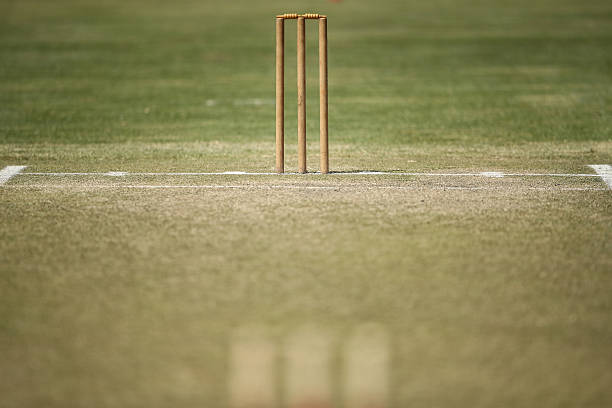19.1 Determining the Boundary
Before the commencement of a cricket match, it is the responsibility of the umpires to ascertain the field of play’s boundaries. These boundaries remain constant throughout the match, as per Law 2.3.1.4 (Consultation with Captains).
19.1.1 The umpires shall determine the boundary before the toss, and this boundary will remain fixed for the duration of the match.
19.1.2 It is crucial that the boundary is determined in such a way that no part of any sight screen is within the field of play at any stage of the match.
19.2 Identifying and Marking the Boundary
Once the boundary is determined, it is imperative to clearly identify and mark it. The following guidelines elucidate how this is accomplished:
19.2.1 Wherever possible, the boundary should be marked by a continuous white line on the ground or by an object in direct contact with the ground.
19.2.2 If a white line is used to mark the boundary:
- 19.2.2.1 The edge of the line nearest to the pitch shall serve as the boundary.
- 19.2.2.2 Flags, posts, or boards used for line marking must be placed beyond the boundary and aren’t part of it.
19.2.3 If the boundary is marked by an object in contact with the ground, the boundary is defined by the edge of the part of the object closest to the pitch.
19.2.4 Flags, posts, or boards can mark points on the boundary if there’s no continuous white line or object. The boundary is then an imaginary straight line on the ground joining the two nearest marked points.
19.2.5 If a boundary cannot be identified using the aforementioned methods, the umpires will determine its location before the toss.
19.2.6 An obstacle within the field of play, except as specified in 19.2.7, is not considered a boundary unless determined by the umpires before the toss (see Law 2.3.1.4 – Consultation with captains).
19.2.7 Any person, animal, or object entering or coming over the field of play while the ball is in play shall not be considered a boundary unless the umpires determine otherwise at the time of contact between the ball and such a person, animal, or object. This decision is made separately for each occurrence (see also Law 20.4.2.12 – Umpire calling and signaling Dead ball).
19.3 Restoring the Boundary
Should a solid object used to mark the boundary be disturbed for any reason, the following actions are taken:
19.3.1 The boundary is considered to be in its original position.
19.3.2 The object should be returned to its original position as soon as practicable, preferably when the ball is dead, even during play.
19.3.3 If any part of a fence or other marker enters the field of play, that part must be removed from the field of play as soon as practicable, ideally when the ball is dead, even during play.
19.4 Ball Grounded Beyond the Boundary
A ball is considered to have landed beyond the boundary if it makes contact with:
- The boundary or any part of an object used to mark the boundary.
- The ground beyond the boundary.
- Any object that is grounded beyond the boundary.
It is also regarded as having landed beyond the boundary if:
- A fielder, grounded beyond the boundary as in 19.5, makes contact with the ball.
- A fielder, after catching the ball within the boundary, becomes grounded beyond the boundary while in contact with the ball, before completing the catch.
19.5 Fielder Grounded Beyond the Boundary
A fielder is deemed to be grounded beyond the boundary if any part of their person makes contact with:
- The boundary or any part of an object used to mark the boundary.
- The ground beyond the boundary.
- An object that is in contact with the ground beyond the boundary.
- Another fielder who is grounded beyond the boundary if the umpire believes it was the intent of either fielder to use this contact to aid in fielding the ball.
19.5.2 If a fielder’s last ground contact before touching the ball wasn’t within the boundary, they’re deemed grounded beyond it.
19.6 Boundary Allowances
Before the toss, umpires and captains determine boundary run allowances, considering customary ground practices.
19.6.1 The umpires and captains decide the runs to be allowed for boundaries, guided by the prevailing custom of the ground.
19.6.2 Unless specified differently under 19.6.1, 6 runs shall be allowed for a boundary 6, and 4 runs for a boundary 4. See also 19.7.
19.7 Runs Scored from Boundaries
Scoring runs from boundaries is subject to specific rules:
19.7.1 A Boundary 6 is awarded only if the ball has been struck by the bat and is first grounded beyond the boundary without touching the ground within the field of play, even if the ball previously made contact with a fielder.
19.7.2 A Boundary 4 is scored when a ball is grounded beyond the boundary:
- Whether struck by the bat or not, and was first grounded within the boundary, or
- Has not been struck by the bat.
19.7.3 When a boundary is scored, the batting side gets either the boundary allowance or completed runs.
19.7.4 Excess runs in 19.7.3.2 replace the boundary allowance for Law 18.12.2 (Batter returning to wicket left).
19.7.5 The scoring of Penalty runs is not affected by the scoring of a boundary.
19.8 Overthrow or Wilful Act of Fielder
If the boundary results from an overthrow or from the wilful act of a fielder, the runs scored shall include:
- Any runs for penalties awarded to either side
- The allowance for the boundary
- Batters’ completed runs and any in-progress run at the time of the throw or act count.
Law 18.12.2 (Batter returning to wicket he/she has left) shall apply as from the instant of the throw or act.



